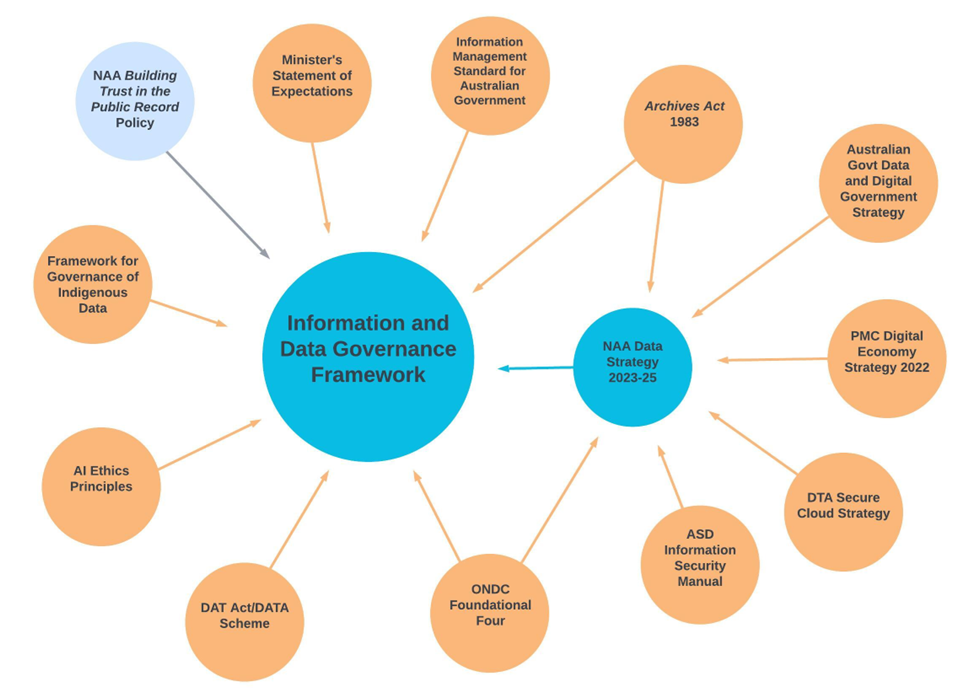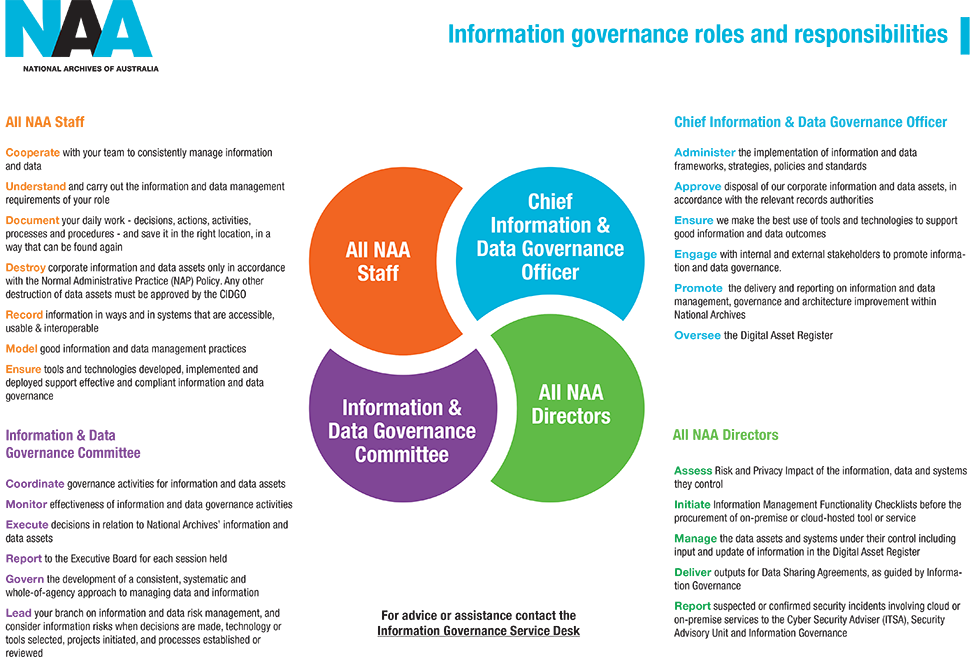2 December 2024
1. Purpose
National Archives Information and Data Governance Framework sets out our practices in response to the environment in which we operate – the Archives Act 1983, other applicable legislation, whole of Australian government policy settings and directives, international and Australian standards, and our internal strategies and policies. The Framework provides a high-level view of the National Archives information and data governance environment. It establishes roles and responsibilities applying to leadership and to all staff of National Archives.
The Framework supports modelling of the National Archives as an exemplar agency with a culture of accountable and business-focused governance of the National Archive's information and data assets. Our information and data are the Archives key differentiator from all other agencies.
This Framework replaces the Information and Data Governance Framework 2021.
“National Archives should be an exemplar in having established governance and reporting arrangements for
internal information management consistent with the Archives Act 1983 and the Building Trust policy.”
The Hon Tony Burke MP, Minister for the Arts, Statement of Expectations, 18 January 2024
2. Framework at a glance
The Information and Data Governance Framework applies to information and data, both corporate and the archival collection entrusted to our custody, in all formats, platforms and locations.
The Framework informs the National Archives Information and Data Management Policy 2023 which:
- provides organisational information and data guidance and requirements on creating, storing, using, and disposing of corporate information and data
- outlines the responsibilities of all staff for the information and data created, managed, controlled, and used in their role
- describes the Archives settings for access, sharing, security and integrity of our corporate and collection information and data; and
- outlines our commitment to continually improve our information and data governance capability.
3. Scope
This Framework applies to all information, data and records created, managed or used by National Archives, in all formats and locations, including the national archival collection in our custody. The requirements of this framework apply to all staff at National Archives, including contractors.
National Archives is the custodians of a large collection of government information and data assets. We also create valuable corporate information and data as part of managing this collection. We will have consistent governance processes, in accordance with our framework, strategies and policies, while recognising that archival and corporate information may require different policy settings.
4. Principles
These principles serve as the foundation for governing information and data at National Archives:
Quality
Trusted and high-quality data is fundamental for confident decision making, with appropriate authority, and for appropriate purposes. Information and data will be defined and documented in a consistent form with appropriate and consistent metadata.
Privacy
We adhere to the obligations of the Privacy Act 1988 and the Australian Privacy Principles which apply to corporate and collection information and data in its use, storage, disclosure and publication of personal information to ensure our handling of personal information is responsible, transparent and ethical.
Authority
Our information and data are held securely, shared appropriately, and retained in accordance with approved records authorities. We govern our information and data to ensure that authentic, complete, and reliable information and data is available to support decisions, provide sound advice, develop good policy, and deliver services and programs effectively.
Innovation
We implement innovative processes, tools, and technologies to enhance consistency, efficiency, capability, authority and quality of information and data. We strive to deliver data analyses, dashboards, reports, and visualisations for information and data-driven decision making.
Custodianship
We are the primary custodian of the archival resources of the Commonwealth. We define our vision for the national archival collection, both digital and analogue, and create our policies, plans and processes to realise this vision. We describe and register our data assets and ensure each asset has a delegated custodian.
Technology
Technology is leveraged to make information and data discoverable, usable, manageable, and insightful, identify trends and anomalies, and optimise data workflows. Information and data often have a lifespan longer than the technology on which they are hosted, so data and information is considered as a separate entity to technology, and governed in accordance with its value and risk.
Collaboration
Our information and data governance systems enhance content collaboration, communication, and accessibility. Staff are supported in their information and data management responsibilities and activities through appropriate and resourced systems, strategies, policies, guidance and procedures, along with information and data governance education and training.
Capture
The capture of information and data in approved information management systems is essential for managing its use and access overtime. Fit for purpose information and data governance storage will allow information and data to inform, implement, document, and communicate our activities and decisions, promoting the ability to work cohesively and provide accessibility.
Access
Information and data are open by default for legitimate business purposes to reduce duplication and improve transparency. This promotes accessibility through appropriate access, formats, and metadata, and through interoperability as needed across systems, channels, and technologies. We promote appropriate information and data sharing with other Australian Government agencies, the Australian community, and where appropriate with our international colleagues and peers.



